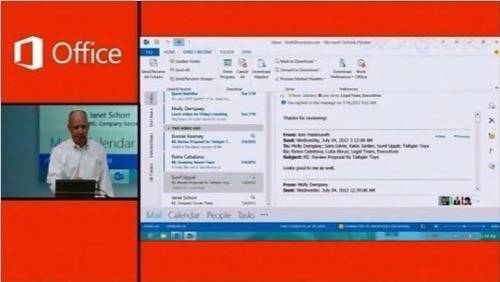
Let’s be clear about what was unveiled Monday afternoon by Microsoft CEO Steve Ballmer in San Francisco: It wasn’t Office 2013 – not really. That would be the conventionally installed software application that could now be described as “offline mode.” Rather, what Ballmer demonstrated was Office 365 incorporating what it should have had to begin with: Office apps running fully as services – not from the hard drive but from the cloud – and looking nearly identical to their conventional counterparts, which will from now on be offered as fallback options.
The Rise of “Office as a Service”
Office 365 began this time last year as an evolutionary mode of licensing the existing Office 2010 software on a monthly basis like a service, with Office Web Apps being added as a placeholder for the fuller online editing functionality users would expect. What Office 365 is now becoming – and indeed, what it should become – is the way to buy Office in the 21st century.

“That’s what it means to say Office is designed as a service: You can just click, and start running Office immediately from the service,” Ballmer told a packed room full of journalists, analysts and customers. “Office uses the cloud to remember what you were doing and where you were, and what your preferences and favorites are, your documents, and how you’re working together with other people… We need to support that for people in their… private lives, in addition to supporting enterprises in their business persona.”
Like Windows, Office must satiate several customer groups simultaneously, even though their requirements are vastly different. What has maintained Office’s dominance in the enterprise up to this point (despite the negative reception to the Ribbon to Office 2007) is its relative consistency and reliability through the years – a huge issue for the traditional desktop computer user. If Microsoft were truly to fundamentally rethink the architecture and mission of its Office apps, devising a model as starkly different from its predecessor as the Windows 8 Start Screen is from the Windows 7 Start Menu, then users in large numbers might simply refuse to upgrade.
The Beginning of the End of Office Web Apps
One possible way to play to all parties might be for Microsoft to redress Office apps in different forms – conceivably, as phone apps, Web apps, Metro-style apps (for Windows 8) and Desktop apps. Microsoft began experimenting with this Medusa-like idea in 2010, with its original Office 365 strategy for the first generation of Office Web Apps.

Office Web Apps were never intended to be as functional as their locally installed counterparts. Instead, they were miniaturized versions of Office apps that recognized existing Office Open XML documents, but could not always create new ones, that saved those documents to Microsoft’s cloud-based SkyDrive storage, and that triggered the launch of real Office apps once they reached the limits of their power. In lieu of full applications, the Web Apps seemed to remind competitors of what Microsoft could eventually do in this space.
Surprisingly, in their roles as scarecrows, Office Web Apps were successful, driving otherwise attractive competitors such as Adobe’s Buzzword into similarly sidelined roles as online accessories to Acrobat. Amazingly, because Office Web Apps behaved as minor league players, Microsoft’s competitors responded with minor league strategies. Google Apps have never nearly been as functional or reliable as conventional Office apps, though they were arguably superior to Office Web Apps. When Google geared its Google Drive storage essentially for Google Apps, it was perceived as a bundling maneuver more characteristic of the old Microsoft.
But bundling works best when an unknown or otherwise undesirable product is bundled with an absolute necessity, such as an operating system – and Google Apps is far from a staple of the enterprise. With its stale usage model, unreliable synchronization and security, and its new reliance upon a service that’s not as flexible as Dropbox or Box, Google Apps is vulnerable. That vulnerability could be exploited by a reliable, proven product that merely relocates itself from the hard disk to the cloud without a great deal of tumult.
Uncharted Waters
So despite Ballmer’s characterization of the new Office 365 as a fundamental rethinking of Office, it obviously is not. And in the real world, that’s actually a good thing. If and when Office fully morphs into Software-as-a-Service, it must still retain its identity. But Monday’s demonstration leaves open many questions about when Microsoft will make the hard choices to change what must still be changed about Office, if it is to truly embrace the “modern office” that Ballmer described:

• The place of Outlook (above) as a communications tool makes more sense in a more hard-wired, 2000s-style client/server environment, where Exchange is but one server, and all accounts are maintained by one PC. This is clearly not the way people want to communicate today, even if Outlook forces them to do so. Adding more Facebook and Skype to Outlook merely adds more hard-wiring to the existing wiring. That’s contrary to the ideal expressed in today’s demonstrations, where Office Division VP Kirk Koenigsbauer showed working with Word in Office 365 on one machine, suspending it, and picking up the same document at the same point on another machine later on. Outlook is the least portable of the Office apps, and nothing exemplifies that fact more clearly than the new, revised SharePoint (below), which uses a flexible, social communications stream that surprisingly takes more than a few cues from Salesforce.


• The divisions between Office applications make less sense in the modern office. While OneNote has been rethought with a more Metro-style-like approach to the arrangement of tabs and the flexibility of inputs, these arguably good ideas should actually be incorporated into Word, which could make the best use of them.

• PowerPoint has perhaps gone the longest without any significant upgrade, and it was a pleasant surprise to see PowerPoint getting the biggest makeover. But in a world where clients and audiences are expecting video and animation to be the foundations of presentations – not just attachments – it was disturbing to see the PowerPoint document still portrayed as a slideshow. In 2013, Apple is likely to push consumer-grade video presentation to new levels, making PowerPoint look like a dinosaur.

• As willing as Microsoft appears to be to incorporate multitouch as a guiding theme, and as much as Windows 8 is adopting rows and columns as its main design ethic, it’s remarkable that Excel – our last solid connection to computing in the 1980s – remains essentially a keyboard-driven ledger sheet. Even the name “PivotTable” cries out for the type of tactile, touch-sensitive functionality that Microsoft is building into other less-needed areas of the software suite.

• The phrase “Windows Phone 8” was brought up several times in discussion. However, the functionality that Koenigsbauer demonstrated smacked of an “Office Web Apps-like” approach – a placeholder for where future functionality should appear, once Microsoft gets around to it. We’ve been expecting a licensing model that lets Office 365 subscribers use Office, or some respectable form of it, on their Windows Phone 8 devices. But for it to truly qualify as Office, it needs to be more comprehensive than merely enabling the user to check SkyDrive (as in Koenigsbauer’s demo shown above) to make sure one’s documents are still there.
Still, Microsoft’s next move with Office needed to be measured and well-orchestrated – and avoid giving business users the feeling of being shoved into a new and bewildering universe. Thus far, Microsoft seems to be navigating that narrow canyon carefully but smoothly with the new Office 365. If businesses move to the new licensing model without executives and employees complaining about the high cost of change in the enterprise, and without the same level of “disruption” we love to see in the consumer space, then this strategy will have succeeded. The trick will be to convince consumers their worlds are being completely made over… when they’re really not.
Lead photo by Fredric Paul for ReadWriteWeb.





















